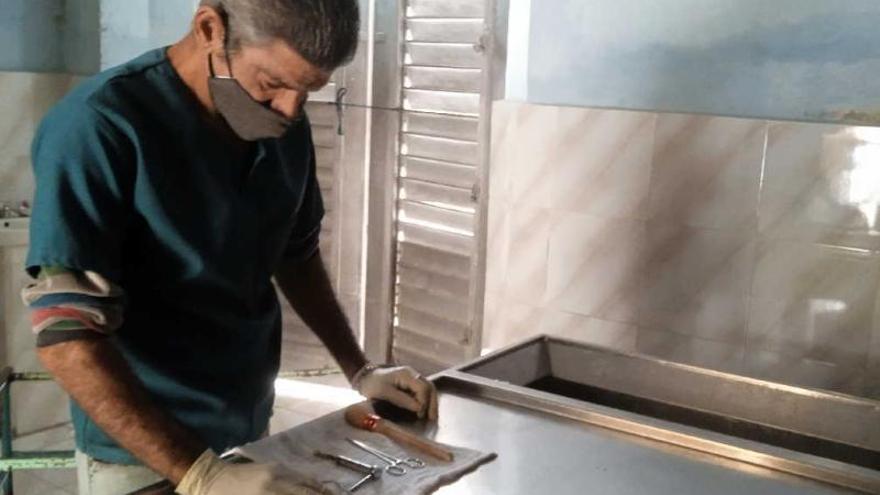
![]() 14ymedio, Havana, 15 February 2024 — From makeup to clothes, the family of the deceased in Sancti Spíritus must provide all the necessary supplies for the preparation of the corpse. Interviewed by the official press, Alberto Gómez, the employee of Communal Services who is in charge of this profession, unveiled the litany of precariousness of his work, which he describes as “necessary and chilling,” in the funeral home of the provincial capital.
14ymedio, Havana, 15 February 2024 — From makeup to clothes, the family of the deceased in Sancti Spíritus must provide all the necessary supplies for the preparation of the corpse. Interviewed by the official press, Alberto Gómez, the employee of Communal Services who is in charge of this profession, unveiled the litany of precariousness of his work, which he describes as “necessary and chilling,” in the funeral home of the provincial capital.
In his testimony, Gómez does not mince words: there is a lack of makeup, “that used to exist”; there is a lack of shaving cream and many “other resources” that he must request from family members. They “help with some of these products, and we appreciate it, because that way we cover the needs that may exist.” However, he adds, “it’s hard.”
Escambray asks Gómez about the “secrets of the hard job of preparing corpses,” and he perches, a little hunched, on his work table. He shows the few instruments he has: a clamp, a brush, a washbasin and a kind of lock pick. The man doesn’t show his face, which he covers with a mask.
The lack of makeup is a serious obstacle, he clarifies, because it prevents “disguising a hematoma” and filling “the cavities of the face, ears and nostrils
In vain, the newspaper tries to downplay the conditions of its work. To each idyllic phrase, such as the one that portrays him as an “artisan of the image,” Gómez opposes strong descriptions of his daily routine, which – in the “good” days – consists of trying to return to the deceased “the shape of the face, the faded colors, the physical presence and even the arrangement of the hair.”
The lack of makeup is a serious obstacle, he clarifies, because it prevents “disguising a hematoma” and filling “the cavities of the face, ears and nostrils.” Gómez says that the family usually wants to see the deceased’s face for the last time, which means leaving the body in the most decent state possible. The issue is complicated, however, when it comes to someone who died in an accident.
“Sometimes I receive a corpse of an injured person and, in general, we try to ensure that it can be exposed, but when it is impossible, due to the disfigurement of the face, then we consult the relatives to approve sealing the coffin and having a photo of the deceased,” he says.
After 12 years as a coffin manufacturer, Gómez is not alien to any of the difficulties of the profession and now accepts the most difficult cases, such as preparing a deceased child, with resignation. “It’s something that makes my teeth itch,” he says, “because it’s very hard to see a small body on that cold table and think that the child didn’t manage to live long enough. But this is the job we have, and someone has to do it.”
The work also includes placing the corpse in the casket, transferring it to the funeral chapel and monitoring it, in case the tropical climate and poor-quality makeup present any “difficulty.” Before the burial, he himself seals the coffin. Other services? The “collection at home” and the arrangements of the deceased in the house itself, when the wake is domestic.
The silent debacle of the Cuban Communal Services has its most evident effect on the inability of the company to collect garbage from the streets
The silent debacle of the Cuban Communal Services has its most evident effect on the inability of the company to collect garbage from the Cuban streets, but it also passes the account to the cemeteries – increasingly neglected and exposed to desecration – and funeral homes. The families of the Island must deal with all kinds of difficulties ranging from the confusion of data – and not infrequently of bodies – to the discovery of open tombs, with bones stolen for ritual purposes.
One of the most serious moments of the crisis occurred after the numerous deaths during the coronavirus pandemic. The small capacity of the cemeteries of many municipalities led to extreme measures, such as burials in mass graves. It was the case in Manzanillo, in Granma province, where the gravediggers told this newspaper that in the neighboring cemetery of the batey San Francisco, up to 200 dead were buried in one day.
Overwhelmed by the number of deaths and by the crudeness of their instructions – they had to bury the deceased three hours after death – the testimonies of the Manzanillo gravediggers do not differ much from those of Gómez in Sancti Spíritus. In Cuba, neither respect or rest is found in death.
Translated by Regina Anavy
____________
COLLABORATE WITH OUR WORK: The 14ymedio team is committed to practicing serious journalism that reflects Cuba’s reality in all its depth. Thank you for joining us on this long journey. We invite you to continue supporting us by becoming a member of 14ymedio now. Together we can continue transforming journalism in Cuba.
